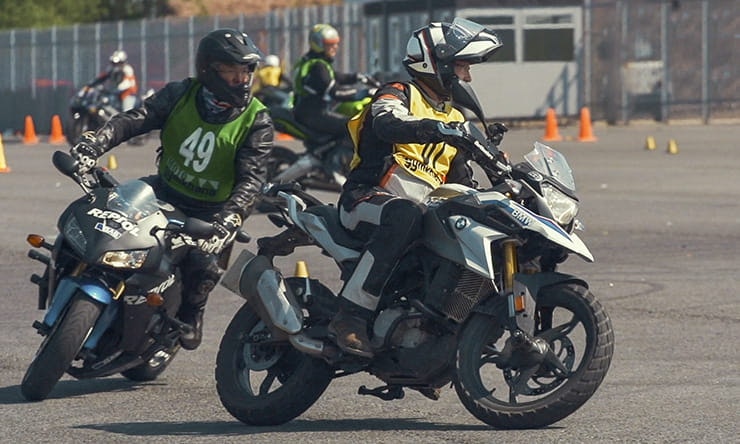Tested: MotoGymkhana experience day review
By John Milbank
Consumer Editor of Bennetts BikeSocial
19.06.2018
Date reviewed: May 2018 | Tested by: John Milbank | Price: £45 | www.moto-gymkhana.co.uk
It really doesn’t matter what you ride – from Harley to adventure bike or Grom to Hayabusa – MotoGymkhana is all about low-speed skills. But that’s not to say it’s slow, dull or boring; navigating the tight array of cones takes huge levels of skill and concentration.
Born in Japan, but now with competitions across 15 countries, MotoGymkhana events – be they practice days or competitions – are usually carried out on a closed tarmac area, like a section of Donington Park race circuit, where I had my first go at the sport…
Ride better with MotoGymkhana
BikeSocial has a go at the best value, most accessible form of motorsport…
What you’ll learn
While there’s a real competition element to MotoGymkhana, you don’t have to actually compete, and there are no egos. This is not a track day, and nobody is going to come barging past you, or try to tuck under the inside as you enter a turn.
I took part in an experience day, which started with a short briefing explaining the coloured cones, then went straight into one-to-one tuition with one of the highly skilled and enthusiastic volunteer riders.
Our first session was on a short course involving weaving between cones and tight 180° turns. I was initially worried that I’d fall off during some of these relatively low-speed manoeuvres, and had kitted out my BMW G310GS with some R&G crash protection. While I’m glad it’s there, I needn’t have worried as each section – and even the competition courses – are laid out in such a way that if you get anything wrong, you can run wide without fear. And if you really do struggle, perhaps by stalling, you’ll most likely be able to just put your feet down.
Bearing in mind that I was on a little 313cc single-cylinder bike, I didn’t stall once – not on the initial course, which we ran several times, the figure of eight course, or the competition section.
You’ll learn to control your bike at lower speeds, which is a huge help when negotiating awkward spaces or turning your bike around in the road; the trick is to relax your shoulders, look where you’re going, keep off the clutch and temper your speed with the back brake. Sounds simple, and to be honest it is, but whether you’re polishing skills you already have, or nailing the perfect U-turn, it’s all extremely valuable for road riding. And constantly trying to better your own time is very addictive…
You really can use any bike at all for MotoGymkhana
Who’s it aimed at?
Anybody can have a go at MotoGymkhana – it doesn’t matter whether you’re a seasoned rider or only have your CBT. You can also do it on absolutely any bike – while I was there I saw big adventure bikes, an MSX125, Harleys, Fireblades, Pan Europeans, GSX-Rs and even a Monkey bike.
What I got out of it
On press launches, I often struggle to move bikes around in the road at photo locations, paddling back and forth as I prepare for the next pass in front of the snapper. While I’m shuffling around, others spin their bike quickly and easily, and the best are those who’ve had a try at – or even competed in – MotoGymkhana.
I’m still far from their level, but I definitely feel far more confident after my experience day. And I’m very tempted to have a go at a competition…
How does it relate to road riding?
Clearly MotoGymkhana will help any rider on any bike to be able to turn their machine around in a U-turn. But it’ll also help them manoeuvre around other difficult areas, like tight parking areas, off-camber slopes, or anything else that requires precise and confident control.
In a MotoGymkhana competition, you have to be able to read the very complicated course, and remember every step – you’d be surprised how hard it is to count the number of times you’ve ridden around a 720° cone when you’re also concentrating on your balance, throttle, brakes and clutch. Riding has to become almost automatic, so you can concentrate on the cones. Apply this to riding on the road, and that ‘spare’ brain capacity can be used for assessing risks and dangers, be they cars pulling out in front of you, or spotting a poor surface before you ride into it…
Verdict
MotoGymkhana is a very cheap form of motorsport, and it’s also incredibly accessible. Plus it’s very low-risk; you’re very unlikely to damage your bike, and even if you did take a tumble, the most serious accident recorded over the years in Europe has been a single broken collar bone.
I really can’t think of any reason not to give it a go, and the skills you learn make it well worth £45…
